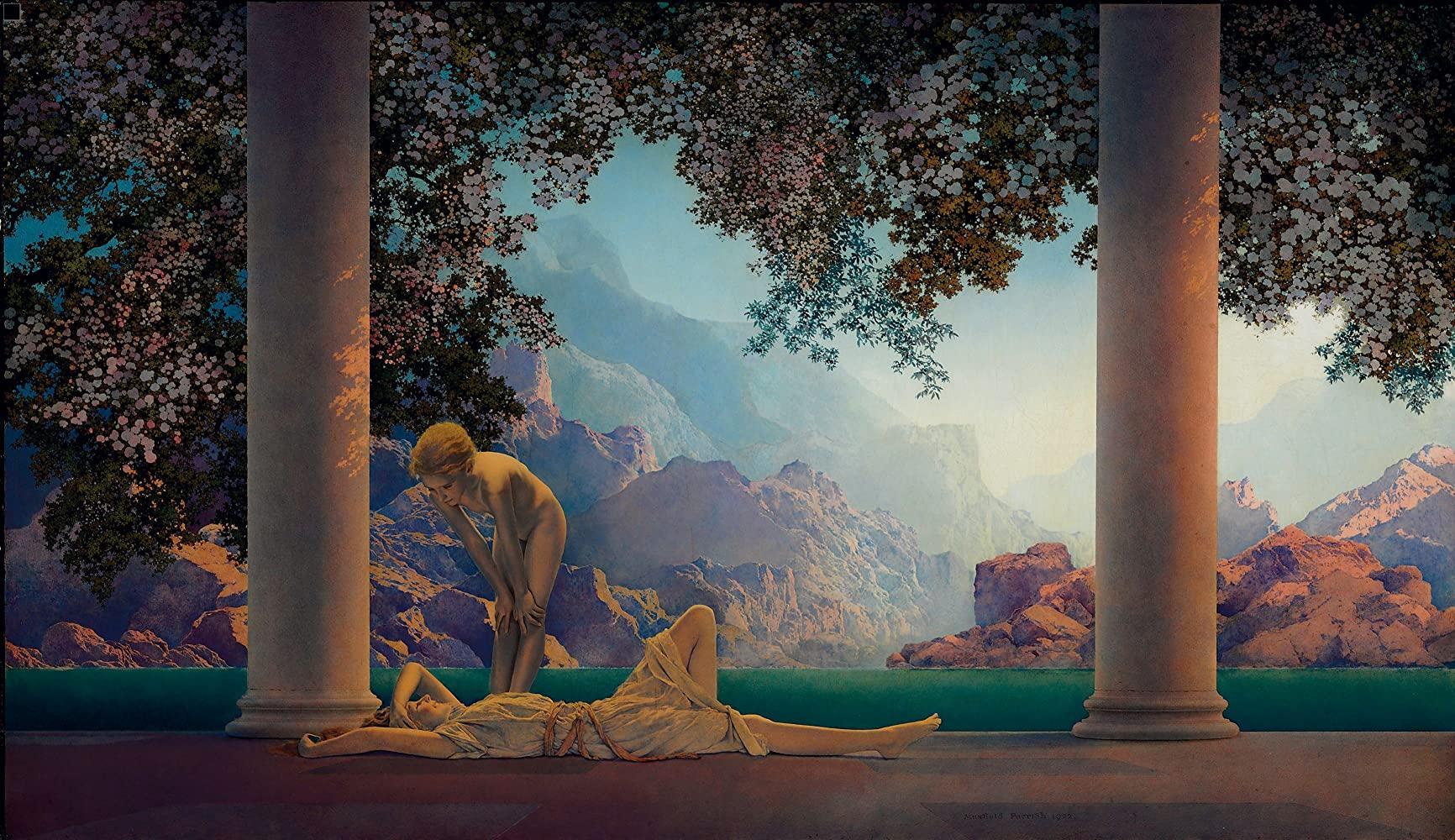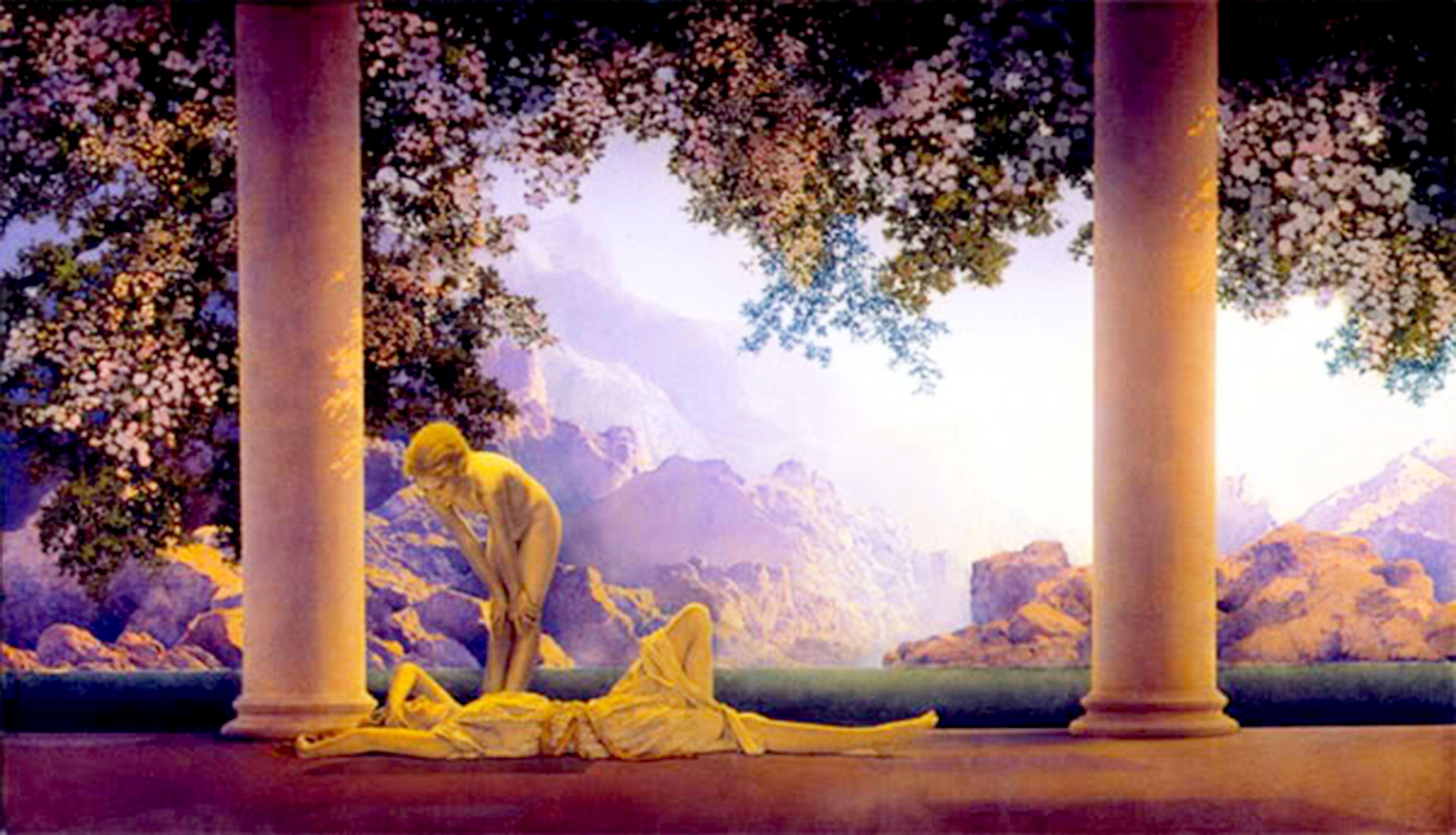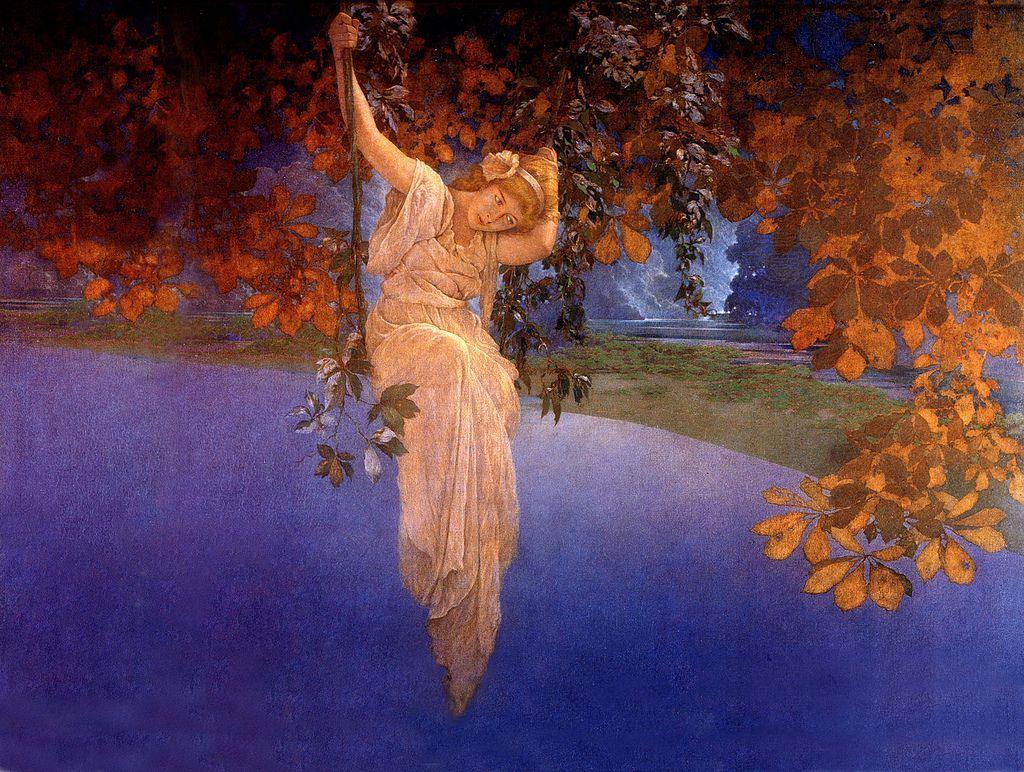Maxfield Parrish: The Master Of Luminous Dreamscapes
Step into a world where light dances with shadow, where mythological figures grace sweeping landscapes, and where every hue shimmers with an almost impossible brilliance. This is the realm of Maxfield Parrish, an American artist whose distinctive vision captured the imagination of a nation and continues to enchant art lovers today. His name became synonymous with a particular brand of ethereal beauty, so much so that one of his signature vivid hues has become known as “Parrish Blue,” a testament to his unparalleled mastery of color.
Born Frederick Maxfield Parrish in Philadelphia, Pennsylvania, this prolific artist, who eventually adopted his grandmother’s maiden name professionally, signed “Maxfield Parrish” to his characteristic illustrations, often depicting whimsical figures set against breathtaking, idealized backdrops. His career, spanning over half a century, saw him evolve from a highly sought-after illustrator to a celebrated painter, leaving an indelible mark on the Golden Age of American Illustration. This article will delve into his fascinating life, explore his unique artistic techniques, and celebrate the enduring legacy of a man whose art brought magic into countless homes.
Table of Contents
- Maxfield Parrish: The Architect of Dreamlike Realms
- Biography: The Life of a Golden Age Master
- Early Life and Artistic Formation: The Seeds of Genius
- The Signature Style: Glazing, Lapis Lazuli, and "Parrish Blue"
- A Career of Two Halves: Illustrator to Painter
- Iconic Works and Enduring Popularity
- The Legacy of Maxfield Parrish: A World Still Revered
- Exploring Parrish's Art Today: Access and Appreciation
Maxfield Parrish: The Architect of Dreamlike Realms
Maxfield Parrish was more than just an artist; he was a visual storyteller who transported millions to fantastical lands. His work, characterized by its meticulous detail, vibrant colors, and idyllic scenes, became a staple in American homes during the first half of the 20th century. It's often said that hardly a home in America existed that didn't proudly display a Maxfield Parrish print, a testament to his widespread appeal and cultural impact. He possessed a unique ability to evoke a dreamlike world, blurring the lines between reality and reverie, making his art instantly recognizable and deeply beloved. This widespread recognition stems from the magical worlds woven by Parrish, often with the color lapis lazuli in its purest form, contributing to the ethereal quality of his pieces.
His influence stretched far beyond the art world, permeating popular culture through his commercial illustrations for magazines like Harper’s Bazaar and Life, and advertisements for major companies such as General Electric. The sheer volume and diversity of his output underscore his incredible talent and tireless dedication. To truly appreciate Maxfield Parrish, one must explore not only his famous murals and iconic paintings but also understand the journey of the man behind these captivating images.
Biography: The Life of a Golden Age Master
Maxfield Parrish, originally christened Frederick Parrish, and known as Fred to close friends and family, eventually adopted his grandmother’s maiden name professionally, signing “Maxfield Parrish” to his characteristic illustrations. Born into an artistic family, his father, Stephen Parrish, was a well-known landscape painter and etcher. This early exposure to the arts undoubtedly shaped his path, providing him with an environment conducive to nurturing his nascent talents. His long life, spanning 95 years, allowed for an extensive and incredibly productive career that witnessed significant changes in both art and society.
His journey from an aspiring young artist in Philadelphia to one of the most popular commercial artists in the United States is a fascinating narrative of dedication, innovation, and unwavering artistic vision. He navigated the evolving landscape of art and commerce, always maintaining a distinctive style that remained true to his unique aesthetic. Understanding his life, awards, relationships, and the places he depicted offers deeper insight into the man who created such beautiful and idealistic paintings.
Personal Data & Biodata
| Attribute | Detail |
|---|---|
| Full Name | Frederick Maxfield Parrish |
| Known As | Maxfield Parrish (professionally), Fred (to close friends/family) |
| Born | July 25, 1870, Philadelphia, Pennsylvania, U.S. |
| Died | March 10, 1966, Plainfield, New Hampshire |
| Nationality | American |
| Field | Illustration, Painting |
| Education | Pennsylvania Academy of the Fine Arts |
| Influences | Howard Pyle |
| Notable Works | Daybreak, Old White Birch, illustrations for Cinderella, Sleeping Beauty |
| Signature Style | Glazing techniques, "Parrish Blue," whimsical mythological scenes, sweeping landscapes. |
Early Life and Artistic Formation: The Seeds of Genius
Maxfield Parrish’s artistic journey began in his native city of Philadelphia, where he received formal education at the prestigious Pennsylvania Academy of the Fine Arts. This institution provided him with a strong foundation in classical art, honing his drawing skills and understanding of composition. However, it was his subsequent study with the renowned illustrator Howard Pyle that proved to be a pivotal influence on his work. Pyle, a giant in the field of American illustration, emphasized storytelling through art, meticulous research, and a commitment to historical accuracy and imaginative detail.
Pyle's teachings encouraged Parrish to develop his unique narrative style, pushing him beyond mere technical proficiency to create images that truly captivated the viewer's imagination. This mentorship helped solidify Parrish's dedication to creating beautiful and idealistic paintings, whether for books, magazines, or murals. The combination of rigorous academic training and the imaginative guidance of Pyle laid the groundwork for the distinctive artistic voice that would soon make Maxfield Parrish a household name.
The Signature Style: Glazing, Lapis Lazuli, and "Parrish Blue"
What truly sets Maxfield Parrish apart is his distinctive style, immediately recognizable for its luminous quality, vibrant colors, and almost photographic precision. He achieved this through a meticulous process involving multiple layers of transparent glazes, a technique that allowed light to penetrate and reflect, giving his paintings an inner glow. This method, combined with his unparalleled use of color, created a visual language all his own.
The Magic of Glazing
Parrish's glazing techniques were central to his ability to create such rich, deep, and luminous colors. He would build up his images layer by layer, often starting with a monochromatic underpainting (grisaille) to establish form and light, then applying thin, transparent glazes of color. This painstaking process, similar to that of the Old Masters, allowed for incredible depth and vibrancy that was difficult to replicate with direct painting methods. The light seemed to emanate from within the canvas, creating an almost magical effect that drew viewers into his whimsical mythological scenes and sweeping landscapes.
The Enigmatic "Parrish Blue"
Perhaps no single element is more emblematic of Maxfield Parrish’s style than his signature use of blue. His particular shade of vibrant, almost electric blue, often seen in his skies, distant mountains, and draperies, became so powerful and distinctive that it earned its own moniker: “Parrish Blue.” This iconic hue, often reminiscent of lapis lazuli in its purest form, contributed significantly to the ethereal and dreamlike quality of his work. It’s a blue that feels both artificial in its intensity and utterly natural in its application, creating a sense of wonder and otherworldliness that few artists have ever achieved. Discover his distinctive style of glazing, his love for landscapes, and his famous works such as Daybreak and Old White Birch, and you'll immediately recognize this characteristic blue.
A Career of Two Halves: Illustrator to Painter
Maxfield Parrish’s career was defined by two distinct phases, illustrating his adaptability and evolving artistic interests. He began his life as an illustrator, a field in which he quickly gained immense popularity and commercial success. His illustrations graced the pages of prominent magazines like Harper’s Bazaar and Life, and he created captivating advertisements for major corporations, including General Electric. His ability to create visually stunning and emotionally resonant images made him the most popular commercial artist in the United States for decades.
In this initial phase, Parrish was known for creating romantic, otherworldly scenes populated by elegant figures, often women in contemplative poses. These illustrations frequently accompanied stories or poems, enhancing the narrative with his unique visual flair. However, as his career progressed, Parrish gradually shifted his focus from illustration to fine art painting. While his earlier works were often commissioned to accompany text, his later paintings stood alone, celebrated purely for their aesthetic merit. This transition allowed him to explore his artistic vision more freely, culminating in some of his most iconic and enduring pieces.
Iconic Works and Enduring Popularity
Among Maxfield Parrish’s vast body of work, certain pieces stand out as particularly iconic, cementing his place in art history. Works like Daybreak (1922) and Old White Birch (1914) exemplify his mastery of light, color, and composition. Daybreak, in particular, became the most reproduced art print in history, a testament to its universal appeal and the artist's ability to create a truly captivating scene. These paintings, with their idealized landscapes and graceful figures, offered an escape into a world of beauty and tranquility, resonating deeply with a public yearning for idealism.
His popularity was not merely confined to fine art prints. Maxfield Parrish produced work for a wide array of commercial ventures, making his art accessible to millions. This broad reach meant that his unique aesthetic permeated American culture, shaping visual tastes and inspiring generations of artists and designers. Everyone recognizes the magical world woven by Parrish, usually with the color lapis lazuli in its purest form, contributing to this enduring appeal.
Murals, Books, and Magazine Covers
Beyond his easel paintings, Maxfield Parrish was also a celebrated muralist, creating large-scale works that adorned public and private spaces. These murals often featured the same fantastical elements and luminous quality found in his smaller works, transforming ordinary rooms into extraordinary realms. His contributions to illustrated books are equally significant. He brought classic tales to life with his enchanting illustrations for works such as Cinderella and Sleeping Beauty, making these stories even more magical for young readers. His ability to interpret and enhance narratives through his art made him a sought-after collaborator for authors and publishers.
His work for magazines like Harper’s Bazaar and Life, and advertisements for companies like General Electric, further solidified his status as a commercial art titan. These commissions allowed him to experiment with different themes and compositions while maintaining his signature style. The pervasive presence of Maxfield Parrish’s art in various forms ensured that his unique vision became deeply embedded in the American consciousness, a phenomenon rarely achieved by any artist.
The Legacy of Maxfield Parrish: A World Still Revered
Maxfield Parrish’s legacy is profound and multifaceted. He remains a prominent figure in the Golden Age of American Illustration, a period marked by an explosion of visual storytelling in print media. His influence can be seen in countless artists who followed, inspired by his technical mastery, imaginative compositions, and unparalleled use of color. His ability to create beautiful and idealistic paintings for books, magazines, and murals set a high standard for commercial art, proving that art could be both commercially successful and aesthetically profound.
Today, his work continues to be celebrated in museums and galleries worldwide. The Maxfield Parrish Museum Inc in Cornish, New Hampshire, where he lived for many years, is a small museum dedicated to celebrating his life and work. This institution, along with others like the National Museum of American Illustration, regularly hosts exhibitions showcasing his original works of art, allowing new generations to experience the genius of Maxfield Parrish. The 2025 winter exhibition, "The Ethereal Worlds of Maxfield Parrish," from the National Museum of American Illustration, for example, promises to feature original works illustrating his genius for evoking a dreamlike world between reality and reverie.
Exploring Parrish's Art Today: Access and Appreciation
For those eager to delve deeper into the world of Maxfield Parrish, numerous resources are available. Major institutions like The Metropolitan Museum of Art house significant collections of his work. As part of the Met's open access policy, you can often freely copy, modify, and distribute images of his works, even for commercial purposes, making his art more accessible than ever before. This digital availability allows for a broader appreciation of his intricate details and vibrant palette.
Beyond digital archives, experiencing Maxfield Parrish’s art in person is an unparalleled experience. The luminous quality of his glazes, the subtle shifts in color, and the sheer scale of some of his murals are best appreciated firsthand. Whether through visiting a museum, attending a special exhibition, or simply admiring a high-quality print, discovering his life, style, and legacy in the golden age of illustration is a journey into a truly magical artistic universe. Explore 117 artworks by Maxfield Parrish, an American Golden Age illustrator and painter known for his glazing techniques, and you'll begin to understand the depth of his contribution.
His ability to create such enduring and universally appealing images ensures that Maxfield Parrish will remain one of our most prominent illustrators and painters, continuing to inspire awe and wonder for generations to come. His vision reminds us of the power of art to transport, to enchant, and to create beauty that transcends time.
Conclusion
Maxfield Parrish, the American artist and illustrator, left an indelible mark on the art world with his unique vision and masterful techniques. From his early career as a highly sought-after illustrator for magazines and books to his later focus on fine art painting, his journey was characterized by a relentless pursuit of beauty and an unparalleled ability to create dreamlike, idealistic scenes. His signature glazing techniques and the iconic "Parrish Blue" continue to captivate, making his work instantly recognizable and deeply cherished. He was, without a doubt, one of the most popular commercial artists of his time, and his influence echoes through the decades.
We encourage you to explore his early career, his famous murals, his books, and his enduring legacy. Dive into the ethereal worlds created by Maxfield Parrish, whether through museum visits, art books, or online collections. What aspect of Maxfield Parrish's art resonates most with you? Share your thoughts in the comments below, and consider exploring more about the Golden Age of American Illustration on our site to discover other fascinating artists who shaped this vibrant era.

Maxfield Parrish Wallpapers - Top Free Maxfield Parrish Backgrounds

Maxfield Parrish Wallpapers - Top Free Maxfield Parrish Backgrounds

Maxfield Parrish Wallpapers - Top Free Maxfield Parrish Backgrounds